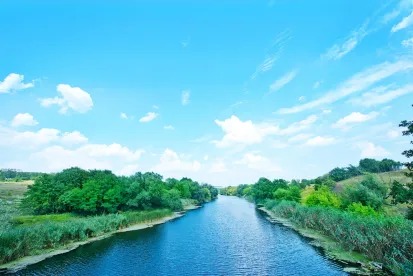Yesterday, the US Environmental Protection Agency (EPA) and the US Army Corps of Engineers (Corps) (together, the Agencies) published a final rule revising the definition of “waters of the United States” (WOTUS) subject to federal regulation and permitting requirements under the Clean Water Act (CWA). This rule is the latest attempt by the Agencies to craft a durable rule defining WOTUS. The new rule, which largely mirrors the 2021 proposal, asserts a broader geographic scope of federal jurisdiction than the 2020 Navigable Waters Protection Rule (NWPR). In particular, the Agencies adopt the broadest possible interpretation of the Supreme Court’s decision in Rapanos (through incorporation of both the plurality’s “relatively permanent” test and Justice Kennedy’s “significant nexus” test). The final rule would, for the first time, codify aspects of the Agencies’ 2008 Rapanos Guidance and would rely on the significant nexus test’s case-by-case approach for evaluating jurisdiction for tributaries, wetlands, and other waters. The Agencies released the final rule while the Supreme Court considers the scope of CWA authority over a major category of WOTUS, “adjacent wetlands,” in Sackett v. EPA, and the Supreme Court could hand down a decision in the coming months that could require changes to the rule.
For project proponents, the new rule would likely mean more features would be subject to regulation under the CWA, and projects that might have previously qualified for nationwide permits may no longer meet the acreage limits and would instead require an individual permit. Also, case-by-case significant nexus determinations could result in lengthy reviews with uncertain and inconsistent results.
The final rule will go into effect on March 20. While the Agencies previously characterized this rule as Phase 1 of a two-step process to enact a new WOTUS definition, EPA recently indicated that it is not currently planning a major second phase.
Summary of Final Rule
The rule defines WOTUS to include:
-
Traditional navigable waters (TNWs), the territorial seas, and interstate waters. TNWs include large rivers and lakes and tidally influenced waterbodies used in interstate or foreign commerce. Interstate waters are rivers, lakes, and other waters that flow across, or form part of, State boundaries. The TNW definition (i.e., all waters currently used, or were used in the past, or may be susceptible to use in interstate or foreign commerce, including all waters which are subject to the ebb and flow of the tide) is consistent with the text of the 1986 regulations and the NWPR. However, the preamble indicates that the Agencies plan to include “waters currently being used for … commercial waterborne recreation (for example, boat rentals, guided fishing trips, or water ski tournaments),” which appears to broaden the scope of TNW waters.
-
Impoundments of WOTUS. The final rule retains the provision in the 1986 regulations that defines WOTUS to include impoundments of WOTUS. The preamble defines impoundments as “created by discrete structures (often human-built) like dams or levees that typically have the effect of raising the water surface elevation, creating or expanding the area of open water, or both.” 88 Fed. Reg. at 3,066.
-
Tributaries. The final rule extends jurisdiction to tributaries of categories 1 and 2 waters if the tributary meets either the Agencies’ new formulation of the relatively permanent or the significant nexus standards from Rapanos (discussed in more detail below). Ephemeral streams that meet the significant nexus test would be jurisdictional tributaries. In this respect, the rule is much broader than the NWPR, which categorically excluded ephemeral tributaries from jurisdiction.
-
Adjacent wetlands. The rule retains the definition of “adjacent” from the 1986 regulations meaning “bordering, contiguous, or neighboring” and adds language that adjacent wetlands are considered WOTUSifthey meet the relatively permanent or significant nexus standards. The NWPR had narrowed the definition of adjacent wetlands to include only those wetlands that abutted or otherwise had a direct surface connection to other jurisdictional waters in a typical year. The final rule creates a broader category of adjacent wetlands, leading to additional regulatory requirements for activities that cross or impact such features.
-
Other waters. The rule asserts jurisdiction over “other waters” under the relatively permanent and significant nexus standards from Rapanos. Under this provision, which essentially serves as a “catch-all” category, “intrastate lakes and ponds, streams, or wetlands” not identified in categories 1-4 can be assessed for jurisdiction under the relatively permanent standard or significant nexus standard. This list is intended to be exclusive, 88 Fed. Reg. at 3,100, but broad enough to include a large variety of water types (e.g., prairie potholes, sloughs, playa lakes, etc.). This category is a clear departure from the 2008 Rapanos Guidance, which did not assert jurisdiction over “other waters” based on the relatively permanent waters or significant nexus standards.
Exclusions. The final rule provides a list of features that are excluded even where they would otherwise qualify as jurisdictional impoundments, tributaries, adjacent wetlands, or other waters. Importantly, features that qualify as category 1 waters (TNWs, territorial seas, and interstate waters) cannot be excluded even if they meet the criteria of the exclusions provided. Key non-jurisdictional waters or exclusions include waste treatment systems, ditches, prior converted cropland, artificially irrigated areas, artificial lakes or ponds, and swales and erosional features. The list of exclusions is similar to the list provided in the 2015 WOTUS Rule and 2020 NWPR, although it does not provide the clear definitions that were included in the NWPR and in some instances changes the exemption based on preamble interpretations.
Key Definitions. The rule also includes a number of important definitions.
-
The “relatively permanent standard” asserts jurisdiction over relatively permanent, standing or continuously flowing waters connected to category 1 waters, and waters with a continuous surface connection to such relatively permanent waters or to category 1 waters. 88 Fed. Reg. at 3,006. The final rule does not define or quantify what constitutes “relatively permanent” flow. The preamble states that the relatively permanent standard encompasses surface waters that have flowing or standing water year-round or continuously during certain times of the year. 88 Fed. Reg. at 3,084.
-
The significant nexus standard asserts jurisdiction over waters that, either alone or in combination with similarly situated waters in the region, significantly affectthe chemical, physical, or biological integrity of category 1 waters. In a change from the proposal, the final rule defines “significantly affect” to mean “a material influence on the chemical, physical, or biological integrity of [category 1] waters.” To determine whether waters, either alone or in combination with similarly situated waters in the region, have a material influence on the chemical, physical, or biological integrity of category 1 waters, the Agencies will assess the list of functions and factors, including, for example contribution of flow, distance from a category 1 water, and hydrologic connections. The preamble states distance from a category 1 water and hydrology—will generally be given the greatest weight in the assessment. 88 Fed. Reg. at 3,120. The new significant nexus standard will likely allow for broader assertions of jurisdiction because it allows the Agencies to aggregate all tributaries and adjacent wetlands within a particular geographic area and evaluate whether they have a “material influence” on category 1 waters based on a case-by-case application of the enumerated factors and functions. This type of case-by-case significant nexus analysis has resulted in lengthy review times as well as unpredictable and inconsistent results.
Existing Jurisdictional Determinations
Landowners may obtain a jurisdictional determination in the form of either: (1) an approved jurisdictional determination (AJD), which is a Corps document identifying the limits of WOTUS on a parcel; or (2) a preliminary jurisdictional determination (PJD), which is a non-binding document in which an applicant can assume all waters will be treated as jurisdictional without making a formal determination.
The Agencies take the position that AJDs issued pursuant to the NWPR may not be relied upon in making new permit decisions. According to the preamble, because the NWPR was vacated by two district courts, NWPR AJDs “may not reliably state the presence, absence, or limits of [WOTUS] on a parcel and will not be relied upon by the Corps in making new permit decisions.” 88 Fed. Reg. at 3,136. The Agencies take the position that AJDs issued under earlier WOTUS definitions—except those AJDs issued under the NWPR—remain valid until the AJD’s expiration date. Also, the new rule will govern any pending requests for AJDs, if the AJD is issued on or after the effective date of the rule (March 20, 2023).
In contrast to AJDs, PJDs are advisory in nature and have no expiration date. The preamble clarifies that the new WOTUS rule has no impact on existing PJDs.
Potential Litigation and the Sackett Case
Multiple challenges to the new rule are likely to be filed in district courts across the country. The state of Texas and an industry coalition immediately filed suits in the U.S. District Court for the Southern District of Texas, and other suits are likely. At the same time, the Supreme Court’s pending decision in Sackett may have implications for the durability of provisions of the rule.
Many commenters recommended that the Agencies defer issuing a final rule until the Supreme Court issues a decision in Sackett—a case in which the issue before the Court is “the proper test for determining whether wetlands are [WOTUS] under the [CWA].” A decision in the Sackett case is expected in the next few months. Perhaps trying to insulate the rule from a potentially unfavorable Supreme Court decision, the Agencies assert in the preamble the severability of the individual provisions of the rule. The preamble states, “if a court were to determine that a wetland cannot be treated as adjacent if it is separated from a jurisdictional water by road or other barrier, the agencies intend that other categories of wetlands within the rule’s definition of ‘adjacent’ would remain subject to jurisdiction.” 88 Fed. Reg. at 3,135. Although it is not clear how the Supreme Court will rule in Sackett, it is possible that the decision could require the Agencies to make changes to the new WOTUS definition or face legal challenges.









 />i
/>i
